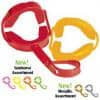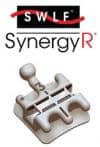by Ari Y. Krug, DMD
Choosing the right material makes tooth movement more accurate and efficient

A Brief History of Wire
Discussed at the Second International Orthodontic Congress in 1931,1 stainless steel began to replace gold as orthodontists’ wire of choice and, by 30 years later, it had totally eclipsed the use of gold. Orthodontics in the 1960s saw the introduction of cobalt chromium alloy wires.2 Nitinol, a new alloy of nickel and titanium, was adapted from the Naval Ordinance Laboratory by Andreason for use as an orthodontic wire.3,4 Modified from the military aerospace industry came wires of a stabilized beta-titanium alloy.5 Stainless steel and alloys of cobalt-chrome, nickel-titanium, and beta-titanium have persevered as the choices of wire material for the orthodontic practitioner.
Why Wires Work
The properties of stainless-steel wires have enabled them to become a mainstay in practically every orthodontic office. Stainless steel’s high yield strength and modulus of elasticity are associated with its characteristic high degree of stiffness, which is advantageous in resisting unintentional deformation.6 However, due to the stiffness, smaller-diameter wires need to be used to engage misaligned teeth. Using smaller wires leads to a loss of control, since there is more “slop” in each bracket-wire interface. Of the commercially available wires, stainless steel exerts the most force per unit of deformation and dissipates that force relatively quickly, resulting in a small range of activity and the need for more frequent adjustments.7 Because stainless-steel wires have demonstrated the lowest amount of bracket-wire friction, sliding mechanics are perhaps the most efficient along stainless steel wires. Stainless steel can be easily formed, welded, or soldered to be used in most clinical applications. After forming, stainless steel should be heat treated to improve the elasticity of the wire.8
Cobalt chromium (Co-Cr) wires demonstrate very similar properties to stainless-steel wires.9 However, with precipitation-hardening heat treatment, Co-Cr exhibits improved resistance to permanent distortion and longer spring function. Recommended protocols for heat-treating Co-Cr wires in a dental furnace are 900°F for 7 to 12 minutes,10 whereas stainless steel is treated at 750°F for 11 minutes.11
Introduced in the 1970s for orthodontic use, nickel titanium’s (NiTi) most characteristic property is its range of springback and flexibility, allowing for very large elastic deflections.12 The deactivation of even large deflections of NiTi wires are accompanied by low and relatively constant forces. The low, constant force enables the substantial clinical advantage of NiTi wires: The orthodontist can insert rectangular wires early and simultaneously resolve leveling, torquing, and malrotation.7 With stainless-steel wires, one must address each of these issues separately, using a progression of archwires increasing in diameter and changing from round to rectangular.
It is worth mentioning multistranded stainless-steel archwires, which possess properties similar to (but poorer than) those of NiTi. NiTi wires have comparable stiffness to multistranded wires with considerably greater ranges of activation, and are not nearly as susceptible to permanent deformation.13 Although multistranded wires can be welded or soldered to, and are less expensive than, NiTi wires, the limitations of their physical properties have caused them to lose favor with many orthodontists.
NiTi cannot be easily formed by bending; all bends need to be greatly overbent, and precise activations of any order are difficult to obtain. NiTi wires also cannot be welded or soldered; therefore, the addition of hooks or other auxiliaries can only be done by crimping onto the archwire. Because of these qualities, NiTi wires are relatively contraindicated for use with standard edgewise appliances and only find their niche with a preadjusted appliance.
Also unique to NiTi wires is their potential to exhibit a shape-memory effect, returning to the manufactured shape when heated through their transitional temperature range. Cooling or gross deformation of these wires shifts them into the martensitic phase, permitting a greater range of deformation. When warmed up, these wires re-enter their austenitic phase and return to their original shape. Various manufacturers claim that these “heat activated” NiTi wires re-enter their austenitic phases at different temperatures, and therefore the clinician can select the shape-recovery properties that best suit the clinical situation. Patients who are mouth breathers, however, may never generate the intraoral temperatures required for phase change back to austenitic, decreasing the usefulness of these wires for this patient segment.14
The most recent alloy to be adapted for use as an orthodontic wire is beta-titanium. These wires possess significantly greater springback than those made from stainless steel and a modulus of elasticity that falls between that of stainless steel and NiTi. Beta-titanium wires have about twice the elastic deformation of stainless steel, are readily formed,7 and can also receive welded auxiliaries. These wires are thus a good choice for creating springs and loops with a greater range of more constant activity. They also require fewer reactivations than similar configurations of stainless steel.
Currently, all archwire materials are alloys of different metals. Future endeavors will most likely try to enhance wire aesthetics while not compromising properties. Ceramic-fiber composite wires are most likely going to be successfully modified to encompass the properties of the currently available wire selection.15
Fighting Friction
Friction between the surfaces of brackets on moving teeth and the archwire results in resistance to tooth movement and therefore requires increased forces to initiate and maintain movement16; therefore, as frictional resistance increases, so does the stress to the anchorage unit. The application of greater force also makes for greater discomfort for the patient. Each wire material imparts a unique tendency (coefficient of friction) to resist movement, partly dictating the appropriate wire selection for each clinical application.
Stainless-steel archwires have the lowest coefficient of friction and thus have the greatest tendency to permit movement. NiTi archwires closely follow stainless steel, and the highest coefficient of friction belongs to the beta-titanium wires.17 Several manufacturers have begun to offer NiTi wires with surface treatments such as ion implantation and Teflon coating, which have demonstrated significant reduction in frictional forces.18,19
Wire Warnings
Different archwire alloys possess unique properties that may be of occasional clinical significance. As much as 20% of the orthodontic patient population may be hypersensitive to nickel or cobalt20; only beta-titanium archwires can be assured not to elicit a reaction in these patients. Fluoride-containing mouthwashes are often prescribed by orthodontists to reduce the risk of decalcifications, but they can also cause corrosion of certain archwires, freeing ions that can lead to adverse reactions and negatively affect the wire surface. NiTi alloys break down more when exposed to stannous fluoride rinses, while copper NiTi demonstrates more breakdown in sodium fluoride.21 Understanding the unique constitution of each alloy further allows ideal archwire selection.
In conclusion, the advances in archwire-material science have enabled progressive orthodontists to simultaneously maximize efficient, comfortable, high-quality orthodontic care. Small-diameter and multistranded stainless-steel wires have mostly been replaced by NiTi wires for the initial phases of treatment, permitting longer appointment intervals with greater range of activation.22 Due to these wires’ shape-memory effect, fewer wire changes are also required. Beta-titanium wires offer formability and a range of activation that are ideal for the intermediate stages of treatment. Stainless-steel wires are the stiffest and retain the lowest frictional values, making them most suited for sliding mechanics or cases requiring precise torque expression. Appreciation of the wire armamentarium that is available facilitates appropriate treatment with the most efficient therapy.
Ari Y. Krug, DMD, is in private practice in Lakewood, NJ. His areas of research have included curing lights, indirect bonding, distraction osteogenesis, dental bleaching, and chronic inflammation. He can be contacted at [email protected].
References
1. DeCoster L. The use of rustless steel in dentofacial orthopedics. Int J Orthod Oral Surg Radiogr. 1932;18:1191–1195.
2. Kusy RP. Orthodontic biomaterials: From the past to the present. Angle Orthod. 2002; 72:501–512.
3. Buehler WJ, Gilfrick JV, Wiley RC. Effects of low temperature phase changes on the mechanical properties of alloys near composition NiTi. J Appl Phys. 1963;34:1475–1484.
4. Andreasen GF, Hilleman TB. An evaluation of 55 cobalt substituted Nitinol wire for use in orthodontics. J Am Dent Assoc. 1971;82:1373–1375.
5. Burstone CJ, Goldberg AJ. Beta titanium: A new orthodontic alloy. Am J Orthod. 1980; 77:121–132.
6. Drake SR, Wayne DM, Powers JM, Asgar K. Mechanical properties of orthodontic wires in tension, bending, and torsion. Am J Orthod. 1982;82:206–210.
7. Kapila S, Sachdeva R. Mechanical properties and clinical applications of orthodontic wires. Am J Orthod Dentofac Orthop. 1989;96:100–109.
8. Funk AC. The heat treatment of stainless steel. Angle Orthod. 1951;21:129–138.
9. Kusy RP. Effects of composition and cross section on elastic properties of orthodontic wires. Angle Orthod. 1981;52:165–179.
10. Filmore GM, Tomlinson JL. Heat treatment of cobalt chromium alloys of various tempers. Angle Orthod. 1979;49: 126–130.
11. Marcotte MR. Optimal time and temperature for stress relief treatment of stainless steel wire. J Dent Res. 1973;52:1171–1173.
12. Andreason GF, Morrow RE. Laboratory and clinical analyses of Nitinol wire. Am J Orthod. 1978;73:142–151.
13. Kusy RP, Stevens LE. Triple-stranded stainless steel wires—evaluation of mechanical properties and comparison with titanium alloy alternatives. Angle Orthod. 1987;57:18–32.
14. Sakima MT, Dalstra M, Melsen B. How does temperature influence the properties of rectangular nickel titanium wires? European J Orthod. 2005;28:282–291.
15. Kusy RP. A review of contemporary archwires: Their properties and characteristics. Angle Orthod. 1997;67:197–208.
16. Drescher D, Bourrauel C, Schumacher HA. Friction forces between bracket and arch wire. Am J Orthod Dentofac Orthop. 1989;96:397–404.
17. Kapilla S, Angolkar PV, Duncanson MG, Jr, Nanda RS. Evaluation of friction between edgewise stainless steel brackets and orthodontic wires of four alloys. Am J Orthod Dentofac Orthop. 1990;98:117–26.
18. Husmann P, Bourauel C, Wessinger M, Jager A. The frictional behaviour of coated guiding archwires. J Orofac Orthop. 2002;63:199–211.
19. Wichelhaus A, Geserick M, Hibst R, Sander FG. The effect of surface treatment and clinical use on frictin in NiTi Orthodontic wires. Dent Mat. 2005;21:938–945.
20. Saglam ANS, Baysal V, Ceylan AM. Nickel and cobalt hypersensitive reaction before and after orthodontic therapy in children. J Contemporary Dent Practice. 2004;5: 2–8.
21. Schiff N, Boinet M, Morgon L, Lissac M, Dalard F, Grosgogeat B. Galvanic corrosion between orthodontic wires and brackets in fluoride mouthwashes. Euro J Orthod. 2006;28:298–394.
22. Andreasen GF, Barrett RD. An evaluation of cobalt-substituted nitinol wire in orthodontics. Angle Orthod 1972;42:172–177.










